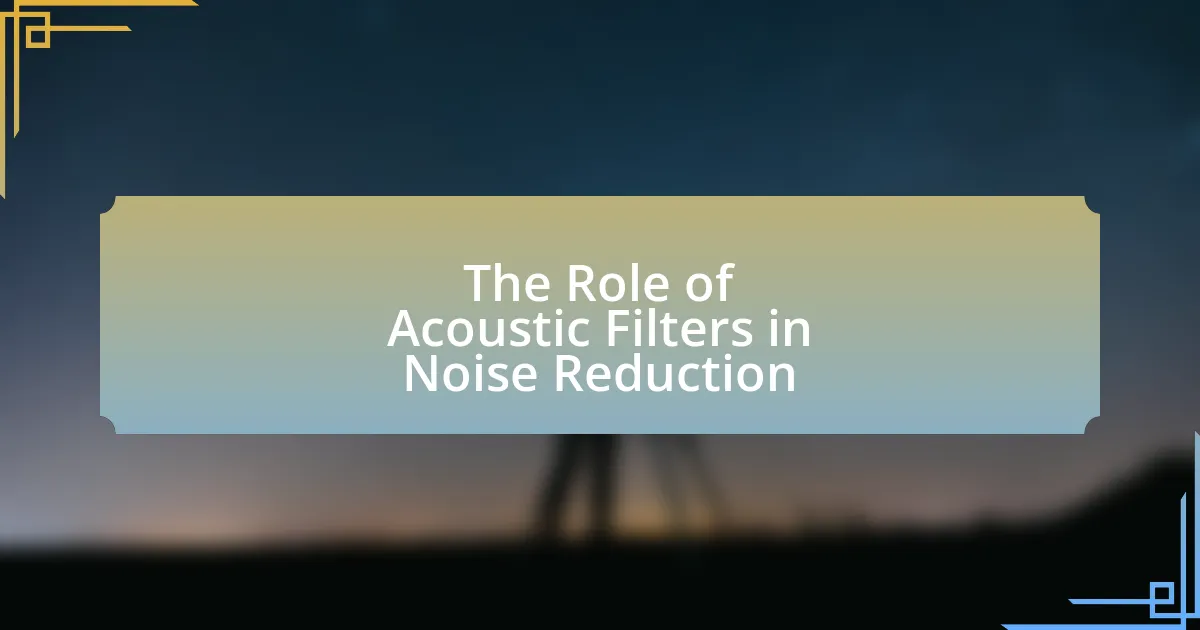Sound waves are longitudinal waves that travel through various media, characterized by properties such as frequency, wavelength, amplitude, and speed. This article explores how sound waves propagate through different materials, the factors influencing their speed, and the impact of temperature on sound propagation. It also examines the interaction of sound waves with geometries, including reflection, refraction, and diffraction, and discusses the implications for architectural acoustics and sound design. Practical applications in engineering, such as noise control and medical imaging, are highlighted, along with best practices for effective sound management and tools for measuring sound wave interactions.

What are Sound Waves and Their Properties?
Sound waves are longitudinal waves that propagate through a medium, such as air, water, or solids, by causing particles in the medium to vibrate back and forth in the direction of the wave’s travel. These waves are characterized by properties including frequency, wavelength, amplitude, and speed. Frequency, measured in hertz (Hz), indicates the number of cycles per second, while wavelength is the distance between successive crests or troughs. Amplitude refers to the maximum displacement of particles from their rest position, which correlates with the loudness of the sound. The speed of sound varies depending on the medium and its conditions; for instance, sound travels faster in water than in air due to the closer proximity of particles. These properties are essential for understanding how sound waves interact with different geometries, influencing phenomena such as reflection, refraction, and diffraction.
How do sound waves propagate through different mediums?
Sound waves propagate through different mediums by transferring energy through vibrations of particles within those mediums. In solids, sound waves travel fastest due to closely packed particles that efficiently transmit vibrations; for example, sound travels at approximately 5,960 meters per second in steel. In liquids, sound waves propagate at a moderate speed, around 1,480 meters per second in water, as particles are less tightly packed than in solids but still allow for effective energy transfer. In gases, sound waves travel slowest, at about 343 meters per second in air, due to the greater distance between particles, which makes energy transfer less efficient. This variation in propagation speed across different mediums is a fundamental characteristic of sound wave behavior.
What factors influence the speed of sound in various materials?
The speed of sound in various materials is influenced primarily by the material’s density and elasticity. Denser materials typically transmit sound waves more slowly due to the increased mass that sound waves must move through, while materials with higher elasticity allow sound waves to travel faster because they can return to their original shape more quickly after deformation. For example, sound travels faster in steel (approximately 5,960 meters per second) compared to air (approximately 343 meters per second) due to steel’s higher density and elasticity. Additionally, temperature can also affect sound speed; in gases, an increase in temperature generally leads to an increase in sound speed because the molecules move more rapidly, facilitating quicker transmission of sound waves.
How does temperature affect sound wave propagation?
Temperature affects sound wave propagation by influencing the speed of sound in a medium. As temperature increases, the speed of sound also increases due to the greater kinetic energy of the molecules in the medium, which facilitates faster transmission of sound waves. For instance, in air, the speed of sound increases by approximately 0.6 meters per second for every 1 degree Celsius rise in temperature. This relationship is grounded in the principles of thermodynamics and gas laws, which demonstrate that warmer air has lower density and allows sound waves to travel more efficiently.
What are the characteristics of sound waves?
Sound waves are longitudinal waves characterized by their ability to propagate through various media, including solids, liquids, and gases. These waves consist of compressions and rarefactions, where regions of higher pressure alternate with regions of lower pressure. Key characteristics include frequency, which determines pitch; amplitude, which affects loudness; wavelength, which is the distance between successive compressions; and speed, which varies based on the medium. For example, sound travels faster in water than in air due to the closer molecular arrangement in liquids. These properties are essential for understanding how sound waves interact with different geometries, influencing phenomena such as reflection, refraction, and diffraction.
What is frequency and how does it relate to pitch?
Frequency is the number of cycles of a sound wave that occur in one second, measured in hertz (Hz). It directly relates to pitch, as higher frequencies correspond to higher pitches, while lower frequencies correspond to lower pitches. For example, a sound wave with a frequency of 440 Hz is perceived as the musical note A above middle C, which is considered a standard reference pitch. This relationship is fundamental in acoustics, as it determines how we perceive different sounds in music and speech.
How does amplitude affect the loudness of sound?
Amplitude directly affects the loudness of sound; higher amplitude results in louder sound. This relationship is due to the fact that amplitude measures the maximum displacement of air particles in a sound wave, which correlates with the energy carried by the wave. Specifically, an increase in amplitude leads to a greater pressure variation in the air, making the sound perceived as louder by the human ear. Research indicates that a sound wave’s loudness increases logarithmically with amplitude, meaning that a doubling of amplitude results in an increase of about 6 decibels in loudness.

How do Sound Waves Interact with Different Geometries?
Sound waves interact with different geometries through reflection, refraction, diffraction, and absorption. For instance, when sound waves encounter a flat surface, they reflect at an angle equal to the angle of incidence, which is described by the law of reflection. In contrast, when sound waves pass through a curved surface, such as a concave or convex shape, they can focus or disperse, altering the sound’s intensity and direction. Additionally, sound waves can bend around obstacles or openings, a phenomenon known as diffraction, which is more pronounced with longer wavelengths. The interaction of sound waves with various geometries is critical in applications such as architectural acoustics, where the design of spaces influences sound quality and clarity. Studies have shown that specific geometric configurations can enhance or diminish sound propagation, impacting how sound is experienced in different environments.
What types of geometries affect sound wave behavior?
Various geometries affect sound wave behavior, including planar, cylindrical, and spherical geometries. Planar geometries, such as flat surfaces, reflect sound waves uniformly, leading to predictable patterns of sound propagation. Cylindrical geometries, like tubes, can create standing waves and influence resonance frequencies, as seen in musical instruments like organ pipes. Spherical geometries, found in certain architectural designs, can focus sound waves to a point, enhancing acoustics in spaces like concert halls. These geometric shapes dictate how sound waves interact with surfaces, affecting their amplitude, frequency, and direction.
How do flat surfaces influence sound reflection?
Flat surfaces significantly influence sound reflection by causing sound waves to bounce off them at predictable angles, following the law of reflection. This law states that the angle of incidence, which is the angle at which the sound wave strikes the surface, equals the angle of reflection, which is the angle at which it leaves the surface. Consequently, flat surfaces can create clear echoes and focused sound paths, enhancing sound clarity in environments like auditoriums or concert halls. Research indicates that the geometry of flat surfaces can lead to constructive interference, amplifying certain frequencies while diminishing others, thus affecting the overall sound quality.
What role do curved surfaces play in sound focusing?
Curved surfaces play a crucial role in sound focusing by directing sound waves toward a specific point or area. This phenomenon occurs because curved surfaces can manipulate the path of sound waves through reflection and refraction, allowing for enhanced sound concentration. For instance, parabolic reflectors are designed to focus sound waves at a single focal point, which is utilized in applications like satellite dishes and certain musical instruments. The effectiveness of curved surfaces in sound focusing is supported by principles of wave physics, where the geometry of the surface determines the angle and direction of the reflected sound waves, thereby optimizing sound delivery and clarity.
Why is understanding sound wave interaction with geometry important?
Understanding sound wave interaction with geometry is important because it directly influences acoustic performance in various environments. The shape and structure of a space can affect sound propagation, reflection, and absorption, which are critical for applications such as architectural design, audio engineering, and environmental noise control. For instance, research has shown that concert halls designed with specific geometric features enhance sound quality by optimizing reverberation times and minimizing unwanted echoes. This understanding allows for the creation of spaces that improve auditory experiences and meet regulatory standards for noise control.
How does geometry impact architectural acoustics?
Geometry significantly impacts architectural acoustics by influencing how sound waves propagate, reflect, and absorb within a space. The shape and dimensions of a room determine the paths that sound waves take, affecting their intensity and clarity. For instance, concave surfaces can focus sound waves, potentially creating hotspots of sound, while convex surfaces may disperse sound, leading to a more uniform distribution. Research indicates that specific geometric configurations, such as the use of angled walls or vaulted ceilings, can enhance sound quality by minimizing echoes and reverberation. Studies have shown that concert halls designed with careful attention to geometry, like the Musikverein in Vienna, achieve superior acoustic performance due to their architectural design, which optimally shapes sound wave interactions.
What are the implications for sound design in various environments?
Sound design in various environments significantly affects auditory perception and experience. Different geometries, such as open spaces, enclosed areas, and irregular shapes, influence sound wave propagation, reflection, and absorption. For instance, in large open environments like concert halls, sound waves travel farther and require careful consideration of acoustics to prevent echoes and ensure clarity. Conversely, in smaller, enclosed spaces, sound waves may reflect off walls, necessitating the use of sound-absorbing materials to minimize reverberation. Research indicates that the shape and materials of a space can alter sound quality; for example, a study by Beranek (2013) highlights how concert hall design impacts listener experience through sound wave interaction. Thus, understanding these implications is crucial for effective sound design tailored to specific environments.

What are the Practical Applications of Sound Wave Interaction with Geometries?
The practical applications of sound wave interaction with geometries include architectural acoustics, medical imaging, and non-destructive testing. In architectural acoustics, the design of concert halls and auditoriums utilizes sound wave behavior to enhance sound quality and clarity, as evidenced by the design principles applied in venues like the Sydney Opera House. In medical imaging, ultrasound technology employs sound waves interacting with body tissues to create images, which is crucial for diagnostics, as demonstrated by its widespread use in prenatal imaging. Non-destructive testing uses sound waves to detect flaws in materials and structures, ensuring safety and integrity in engineering applications, such as in the aerospace industry where ultrasonic testing is standard practice.
How can sound wave principles be applied in engineering?
Sound wave principles can be applied in engineering through techniques such as ultrasonic testing, acoustic imaging, and noise control. Ultrasonic testing utilizes high-frequency sound waves to detect flaws in materials, ensuring structural integrity in aerospace and civil engineering applications. Acoustic imaging employs sound waves to create visual representations of objects, aiding in non-destructive testing and medical diagnostics. Noise control engineering applies sound wave principles to design spaces that minimize unwanted noise, enhancing comfort in buildings and transportation systems. These applications demonstrate the critical role of sound wave principles in improving safety, efficiency, and quality in various engineering fields.
What techniques are used to optimize sound in concert halls?
Techniques used to optimize sound in concert halls include acoustic design, sound diffusion, and absorption materials. Acoustic design involves shaping the hall’s geometry to enhance sound propagation and minimize echoes, with features like vaulted ceilings and angled walls. Sound diffusion techniques, such as the use of diffusers, scatter sound waves evenly throughout the space, preventing dead spots. Absorption materials, like acoustic panels and carpets, are strategically placed to reduce excessive reverberation, ensuring clarity of sound. These methods are supported by studies in architectural acoustics, which demonstrate that proper design significantly improves auditory experiences in performance venues.
How do sound wave interactions inform the design of noise barriers?
Sound wave interactions inform the design of noise barriers by determining how sound is reflected, absorbed, and diffracted by various materials and shapes. Engineers analyze these interactions to optimize barrier height, thickness, and material composition, ensuring maximum sound attenuation. For instance, studies show that barriers with irregular surfaces can scatter sound waves more effectively than smooth surfaces, leading to better noise reduction. Additionally, the frequency of sound waves influences design; lower frequencies require denser materials for effective absorption, while higher frequencies can be mitigated with lighter, porous materials. This understanding of sound wave behavior directly impacts the effectiveness of noise barriers in urban environments.
What best practices should be followed for effective sound management?
Effective sound management involves implementing strategies such as sound insulation, sound absorption, and sound diffusion. Sound insulation minimizes sound transmission between spaces, which can be achieved through materials like acoustic panels and double-glazed windows. Sound absorption reduces reverberation and echoes within a space, often utilizing soft furnishings and specialized acoustic materials. Sound diffusion helps to evenly distribute sound waves, preventing hotspots and dead zones, and can be accomplished with diffusive surfaces or structures. Research indicates that environments designed with these principles can enhance acoustic comfort and improve overall sound quality, as evidenced by studies in architectural acoustics.
How can one assess and improve sound quality in a given space?
To assess and improve sound quality in a given space, one should conduct an acoustic analysis, which involves measuring sound levels, frequency response, and reverberation time. Acoustic analysis can be performed using tools like sound level meters and software that analyzes sound waves, allowing for the identification of problematic areas where sound may be distorted or unclear.
Improvement can be achieved through various methods such as adding sound-absorbing materials like acoustic panels, carpets, or curtains to reduce reflections and reverberation. Additionally, adjusting the layout of furniture and speakers can enhance sound distribution. Research indicates that spaces with optimized acoustics can improve clarity and overall listening experience, as demonstrated in studies on room acoustics by researchers like Beranek and Kuttruff, which highlight the importance of geometry and material in sound quality.
What tools are available for measuring sound wave interactions with geometries?
Tools available for measuring sound wave interactions with geometries include acoustic cameras, laser Doppler vibrometers, and finite element analysis software. Acoustic cameras utilize arrays of microphones to visualize sound fields and identify how sound waves interact with surfaces. Laser Doppler vibrometers measure the velocity of vibrating surfaces, providing insights into how sound waves affect geometries. Finite element analysis software, such as COMSOL Multiphysics, allows for simulation and analysis of sound wave propagation and interaction with complex geometrical shapes, enabling precise modeling of acoustic behavior in various environments.





